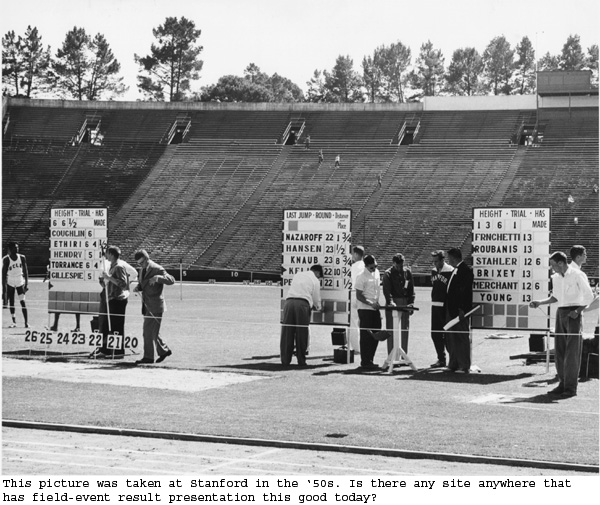IF YOU’RE LIKE MOST FANS, YOU LIKE TRACK MORE THAN FIELD. I tend to be of the opposite persuasion, but the way “athletics” is presented, it’s certainly a lot easier to be enamored of running competitions. It’s simple to appreciate a race—any race—because it really doesn’t matter how far it is or how fast the people are running. Just watching them go head-to-head, running from point A to point B as fast as they can, is about as good as it gets in sporting entertainment.

And you can tune into the action in the middle of a race and still instantly know enough of what’s going on. Would that appreciating jumping and throwing were so easy.
Can you imagine watching any of the popular ball sports without a scoreboard? No indication of the score, no idea how much time is left in the game? Anybody who tried to sell a sport with that kind of spectator aid would be laughed off the planet.
Yet that’s just what happens with field events, which not only make up about half the disciplines in the sport, but also dominate the landscape in terms of time of competition. But walk into a track meet at any level—even the World Championships or Olympic Games—and your chance of finding out what’s going on in any of the jumps or throws is almost impossible. Even with all the marvels of modern electronics.
If you’re lucky enough to be at a high-end meet, there will be high-tech indicators, yes, but they will tell you only what position the current performer is in before giving you the latest mark. So if your attention has been focused on the 1500 final for the previous 5:00 and you turn to the triple jump you’ll be thrilled to see that the guy currently in 9th is on the runway. No clue as to who is the leader, let alone who’s in the medal positions.
The announcer, no matter how good he is, probably won’t have the time to recap the whole event for you (although the good ones try). The scoreboard? It’s usually too busy with pictures to—heaven forbid!—put up something like field event results until the event is over.
Not to pick on Stanford, but it provides the best example of how the sport has gotten off-track (no pun intended) in the field-event presentation department. The school has a cutting-edge million-dollar scoreboard that produces fabulous images and has greatly enhanced the average fan’s viewing pleasure, to be sure. But nowhere can you find ongoing field-event results. Yet 50 years ago (!) at the same school, you could. Just look at the photo.
I can understand that your everyday meet can’t have that kind of aid, but how can the IAAF and USATF run the sport at the international and national championship level without ensuring that the fans know what is going on at all times in all events on the program?